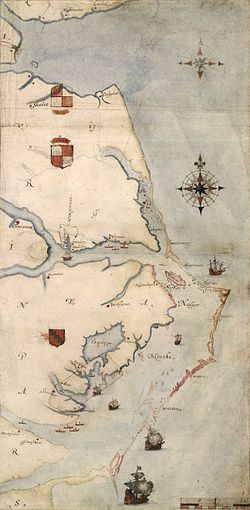Lost Colony of Roanoke
| Roanoke Colony | |||||
| Colony of England | |||||
|
|||||
| Virginea Pars map, drawn by John White during his initial visit in 1585. Roanoke is the small pink island in the middle right of the map. | |||||
| History | |||||
| • | Established | 1585 | |||
| • | Birth of Virginia Dare | August 18, 1587 | |||
| • | Abandoned | Before August c.1590 | |||
| • | Found abandoned | August 18, 1590 | |||
| Population | |||||
| • | 1587 | 116 | |||
| Today part of | United States | ||||
The Roanoke Colony, also known as the Lost Colony, was established in 1585 on Roanoke Island in what is today's Dare County, North Carolina. It was a late 16th-century attempt by Queen Elizabeth I to establish a permanent English settlement in North America. The colony was founded by Sir Walter Raleigh.
The colonists disappeared during the Anglo-Spanish War, three years after the last shipment of supplies from England. Their disappearance gave rise to the nickname "The Lost Colony". There is no conclusive evidence as to what happened to the colonists.
The enterprise was originally financed and organized by Sir Humphrey Gilbert, who drowned in 1583 during an aborted attempt to colonize St. John's, Newfoundland. Sir Humphrey Gilbert's half-brother Sir Walter Raleigh later gained his brother's charter from the Queen and subsequently executed the details of the charter through his delegates Ralph Lane and Richard Grenville, Raleigh's distant cousin.
On March 25, 1584, Queen Elizabeth I granted Raleigh a charter for the colonization of the area of North America. This charter specified that Raleigh needed to establish a colony in North America, or lose his right to colonization.
The Queen and Raleigh intended that the venture should provide riches from the New World. The queen's charter said that Raleigh was supposed to "discover, search, find out, and view such remote heathen and barbarous Lands, Countries, and territories ... to have, hold, occupy, and enjoy".
The queen's charter also said that Raleigh was supposed to establish a base from which to send privateers on raids against the treasure fleets of Spain. The purpose of these raids was to tell Spain that England was ready for war. The original charter basically told Raleigh to establish a military base to counteract the activities of the Spaniards. Raleigh himself never visited North America, although he led expeditions in 1595 and 1617 to South America's Orinoco River basin in search of the legendary golden city of El Dorado.
...
Wikipedia

